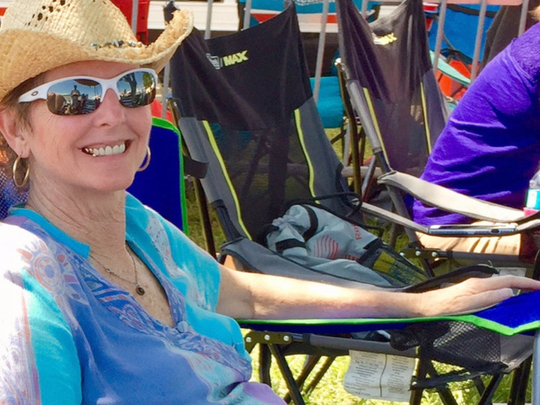
In an awful way, it all made perfect sense, Gail T. Wells remembers thinking as neurologist Thy Nguyen matter-of-factly explained that she was ordering tests to check for an underlying cancer.
Cancer would explain the worsening symptoms - abdominal pain, incessant cough, weight loss and crushing fatigue - that had plagued Wells, to the puzzlement of her doctors.
“I felt like I was dying,” said Wells, a nurse practitioner, of her initial meeting in February 2016 with Nguyen, an assistant professor of neurology at the University of Texas Health Science Centre in Houston. “I really wasn’t surprised. It was more like a kind of resignation.”
But it was a resignation punctuated by icy stabs of fear, as Wells quickly underwent a mammogram and other scans in an effort to pinpoint where a malignancy might be lurking. She broke the news to her husband and their four grown children, reviewed her funeral arrangements and tried to steel herself for what lay ahead.
Four days later, the neurologist called. Wells’s bloodwork showed no sign of cancer. In fact, most tests were normal. But one revealed a long-standing problem Wells had never known about.
“You could have told me I was pregnant, that’s how astonished I was,” recalled Wells, who was then 62.
The finding proved to be the key to her diagnosis and subsequent successful treatment. The possibility had been repeatedly overlooked because Wells had not shown the manifestations common to someone with her condition.
In 2005, after years of working in hospitals, Wells founded a primary-care clinic in Houston to treat people who were uninsured or underinsured.
She had long thrived on a pace others might consider grueling: 12-hour workdays during which she was often too busy to eat. To stay in shape, she ran and worked out regularly. Her only notable health problem was sporadic migraines.
About 15 years ago, after taking a powerful anti-seizure drug used to treat migraines, she developed numbness, or neuropathy, in her toes. The problem abated when she stopped the drug, but it never entirely disappeared.
In 2010, Wells developed heartburn and, later, a chronic cough, which she attributed to acid reflux.
In 2013, when her husband retired, Wells did, too. She sold her clinic, and the couple decided to spend more time travelling. Over the next two years, they visited Portugal, Spain, Italy and the Caribbean, trips that Wells found increasingly joyless and difficult. She noticed that normal activities, such as walking for exercise in her neighbourhood, were becoming physically taxing.
She and her husband thought that she might be depressed. Wells had been busy for so many years that, once retired, she had relatively little with which to fill her days. To counter her malaise, she took a few graduate medical courses and registered with an agency for temporary nursing jobs.
Neither helped. Her fatigue worsened, and she found interacting with people increasingly exhausting. Some days, she didn’t have the energy to get out of her pajamas.
Wells also developed an odd new problem. Once or twice a month, she would awaken from a sound sleep with intense abdominal cramps. Vomiting would sometimes relieve the pain, which typically disappeared after about eight hours, leaving her feeling wiped out.
Wells had also lost about three kilograms between 2013 and 2015, which she attributed to better eating habits and the elimination of the two glasses of red wine she habitually drank after work. Because unintended weight loss can be a sign of underlying illness - including cancer - her primary-care doctor ordered tests to check her liver, kidneys and pancreas.
Everything looked normal. The doctor recommended that she see a gastroenterologist. Wells had never undergone a colonoscopy, which is recommended at age 50 for people at normal risk.
“I’m a big chicken,” she said.
But in August 2015, before she made a gastroenterology appointment, Wells experienced an unnerving episode. Her left leg and lower lip suddenly went numb, and her tongue began tingling. Wells said she didn’t think she was having a stroke because she could think clearly; the symptoms abated within hours. She saw a neurologist, who suspected multiple sclerosis or a vitamin B deficiency, both of which were soon ruled out. But a nerve conduction test, which uses electrodes attached to the skin to assess damage, showed decreased rates of nerve conduction in her left leg and both feet.
Because no underlying cause could be found, Wells was diagnosed with idiopathic degenerative neuropathy - nerve deterioration for no apparent reason - and advised to stay physically active to preserve muscle function.
That became increasingly difficult.
During Houston’s mild winters, her feet felt constantly numb and cold, like “blocks of ice.” She wore wool socks around the clock and slept beneath an electric blanket and two comforters. Her cough worsened, and Wells periodically felt short of breath, even though a chest CT scan and a TB test were normal.
“I felt like I was aging super-fast,” she said. “I thought, ‘How do people manage in their 70s and 80s?’ “
In February 2016, she consulted Nguyen for a second opinion.
“I remember she was tearful,” Nguyen said. “She said, ‘I’ve been looking forward to retiring, and now I can’t do anything.’ “ Her neurological exam, Nguyen added, was consistent with the weakness she described.
Nguyen decided to repeat the nerve conduction test, which showed a significant worsening. “Things were going kind of fast, and that’s very unusual,” Nguyen said. “At that point, you have to start thinking out of the box.”
The neurologist ordered sophisticated blood tests. Among the most likely culprits, she thought, were a paraneoplastic syndrome (whose symptoms are caused by substances circulating in the blood in response to a cancer), elevated levels of vitamin B6 or Sjogren’s syndrome, an autoimmune disorder that attacks mucous members and joints.
Four days later, Nguyen received the results of Wells’s blood tests.
“I was pretty surprised - and I was nervous to call her” to break the news, the neurologist recalled.
There was no sign of an underlying cancer. But Wells was clearly infected with hepatitis C, a potentially fatal disease that can cause liver cancer.
For reasons that aren’t clear, hepatitis C is most common among the members of Wells’ generation: baby boomers born between 1946 and 1964. It is also an occupational hazard for health-care workers, the result of accidental needlesticks or other contact with a patient’s infected blood. Before 2014, there were no oral medicines specifically approved to treat hepatitis C, which was discovered in 1989.
“I was gobsmacked” by Nguyen’s news, Wells recalled. She knew, and had told all her doctors, that she had been exposed to another infection, hepatitis B, years earlier, most likely in 1983 while working in an emergency room on a drug dealer who was bleeding profusely after a machete attack. Days after the incident, she had tested positive for hepatitis B. Like 95 per cent of adults, Wells cleared the virus from her system and then became immune to hepatitis B.
But most adults are unable to clear hepatitis C from their bodies and unknowingly go on to develop a serious, chronic infection that can fester for years, damaging their livers.
Wells suspects she was exposed to hepatitis C during the same incident because co-infections were common in those days.
But her liver function tests had always been normal.
So what exactly was the cause of her symptoms?
Wells turned out to have a rare disorder caused by hepatitis C known as Type 2 mixed cryoglobulinemia.
It occurs when cryoglobulins - abnormal proteins in the blood - thicken and clump together, restricting blood flow to surrounding organs and causing damage to blood vessels. Cryoglobulins often develop in response to hepatitis C or an autoimmune disorder; roughly half of those with a chronic hepatitis C infection are believed to have cryoglobulins circulating in their blood, but fewer than 30 per cent of them develop symptoms. Those signs include fatigue, abdominal pain, weakness, neuropathy and Raynaud’s disease, a reaction to cold temperatures or stress that can result in a narrowing of blood vessels. Cryoglobulinemia is three times as common in women as in men. Most cases have been reported in those between ages 40 and 60.
“It’s the most common manifestation of hep C outside the liver,” Nguyen said. “In Europe, it’s more commonly recognised.”
The disorder was overlooked, Nguyen speculated, because Wells’ symptoms - abdominal pain, numbness, fatigue - are common to many other diseases. And before Nguyen, no doctor had ever thought to screen Wells for hepatitis C.
Wells consulted a liver specialist, and in the summer of 2016 began a 12-week course of treatment with Harvoni, a medicine that costs about $92,000 (Dh337,000) and is considered to effectively cure hepatitis C. The cryoglobulin count in her blood steadily decreased, and by April of this year it was undetectable. (Although doctors didn’t know at the time that Harvoni could reactivate her hepatitis B, Wells suffered no such complication.)
Nearly all of her symptoms, except the leg numbness, disappeared.
“I was just so relieved to have a cause,” she said, “and so blown away that we actually had a cure.” She is especially relieved that her family tested negative: Hepatitis C can sometimes be transmitted during childbirth and to those who live in the same house.
Wells says she feels “a renewed appreciation for life every waking hour.” Her energy level has rebounded, and she feels well enough to take week-long out-of-town work assignments.
She wonders how many other people might have simmering hepatitis C infections or cryoglobulinemia, without knowing it.
“If I had not had hepatitis B,” she said, “would anybody have found this?”
–Washington Post













